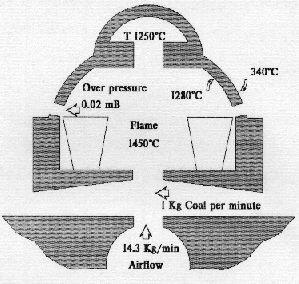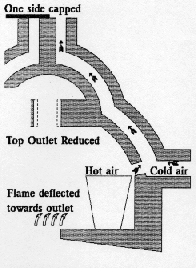This illustration is taken from the front sheet of a book on glass-making published in Amsterdam in 1669. We believe the illustration is based on the furnace in the St Jacobsgasthuis in Nijmegan in Holland that was developed about 1666. Part of this building still stands. The particular features to note on this illustration are the square holes at mid-height of the figure and the strangely-shaped flat plate on the top of the furnace structure. We believe these were part of a innovative air-duct system that allowed these glass makers to vary the temperature in different parts of the furnace. Click here to download a paper we wrote in 1992 that explains how this furnace probably worked (note: it is approximately 1MB) and here for a more recent paper (2001) with more up-to date research in it (178KB).


Simple computer-modelling has shown that this arrangement could have been very effective and may well have opened the way to using the new kinds of glass that were introduced within the next decade, such as lead glass that was used in Holland, England and Sweden and the potash-lime glass that was used in Germany. The left hand figure shown above gives a section through the kind of furnace described by Christopher Merret in 1662 and the right hand one shows how the air ducts might have been added a few years later, and the effect they had. The principles behind this air-duct system almost certainly relied on the scientific research of the German chemist Johann Glauber who worked initially in the Rhine valley (Nijmegan is on the Rhine close to the Holland-German border) before moving to Amsterdam. The first of his papers on his experiments on furnace design was published about 1646.
One glass house not yet 'on the map' is that at Calne, Wiltshire. As far as we know if worked for only a short part of this period, perhaps less than ten years. For more details see: calne.htm
|
|
The 'clickable' links opposite lead to pages describing what is known about individual glass houses that were probably making drinking glasses during the period. These are in England, but two American sites are included below because they were set up by English glass makers and probably worked in the English style. |